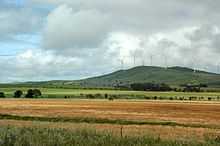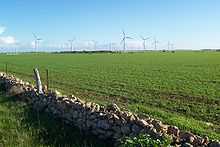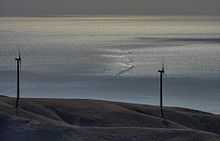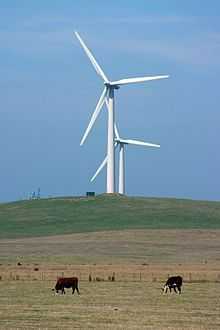Wind power in South Australia

Wind power has become a significant energy source within South Australia over the past decade. As of August 2014, there was an installed capacity of 1,473 MW, which accounts for 27 per cent of electricity production in the state.[1] This represents around half of the nation's installed wind power capacity. The rapid growth of wind power in South Australia has enabled the state to achieve its target of sourcing 20% of electricity from renewable energy sources three years ahead of schedule.[2]
The development of wind power capacity in South Australia has been encouraged by a number of factors. These include the Australian Government's Mandatory Renewable Energy Target, which require electricity retailers to source a proportion of energy from renewable sources, incentives from the South Australian Government including a supportive regulatory regime and a payroll tax rebate scheme for large scale renewable energy developments. Also the state's proximity to the Roaring forties means there are high quality wind resources for wind farms to exploit. In mid-2009, RenewablesSA was established by the South Australian Government to encourage further investment in renewable energy to the state.[3]
The load factor (or capacity factor) for South Australian wind farms is usually in the range 32-38%. This means that a wind farm could typically produce between 32 and 38% of its nameplate capacity averaged over a year.[4]
Wind farm overview

In 2003 the only large wind turbine in South Australia was a 0.15 MW unit at Coober Pedy and by early 2004 there was 34 MW of installed wind power capacity.[4]
As of December 2010, South Australia had thirteen operational wind farms, with an installed capacity of 1,018 MW. South Australia had half of the nation's installed wind capacity, despite only making up 8% of Australia's population. A further 184 MW of projects were under construction. It is estimated that wind power provided 14% of South Australia's energy demand in 2008/09.[5][6][7]
AGL Energy is a major developer of wind farms in Australia with many new projects in production or planned. By 2011 the company expects to produce 460 MW using 232 wind turbines in South Australia, supplying an estimated 250,000 households with electricity.
As of August 2014, South Australia had an installed capacity of 1,473 MW, accounting for 27 per cent of electricity production.[1]
| Installed capacity (MW) | Wind farm | Developer | Generating since... |
|---|---|---|---|
| 270 | Snowtown 2 Wind Farm | Trustpower | November 2014 |
| 159 | Lake Bonney Stage 2 | Infigen Energy | September 2008 |
| 132 | Hallett 4 Wind Farm | AGL Energy | June 2008 |
| 111 | Waterloo Wind Farm | Roaring 40s | 2010 |
| 99 | Snowtown 1 Wind Farm | Trustpower | 2008 |
| 95 | Hallett 1 Wind Farm | AGL Energy | March 2007 |
| 91 | Wattle Point Wind Farm | AGL Hydro | June 2005 |
| 80 | Lake Bonney Stage 1 | Infigen Energy | March 2005 |
| 71 | Hallett 2 Wind Farm | AGL Energy | |
| 70 | Mount Millar Wind Farm | Meridian Energy | February 2006 |
| 66 | Cathedral Rocks Wind Farm | Roaring 40s | 2005 |
| 56 | Clements Gap Wind Farm | Pacific Hydro | |
| 52 | Hallett 5 Wind Farm | ||
| 46 | Canunda Wind Farm | International Power | March 2005 |
| 39 | Lake Bonney Stage 3 | Infigen | 2010 |
| 34 | Starfish Hill Wind Farm | Transfield Services | July 2003 |
South Australia has provided regulatory certainty for wind farms, and the government has implemented land use planning policies which represent national best practice for accommodating wind farms.[6] On 2 June 2009, Premier Mike Rann announced plans to increase South Australia's renewable energy production target to 33% by 2020, well above the national target of 20% by 2020.[6]
Completed wind farms

Hallett Wind Farm (350 MW)
Hallett 1 wind farm, consists of 45 Suzlon S88 turbines each of a rated 2.1 megawatt (MW) for a total of around 95 MW. It is in the Mid-North of South Australia adjacent to an existing 180 MW gas fired peaking power plant.[10] The wind farm construction was carried out by Suzlon Energy Australia Pty. Ltd. Hallett 2, 4 and 5 are also complete.
Lake Bonney Wind Farm (278.5 MW)
Lake Bonney Wind Farm was built in three stages. Stage 1 consisted of 46 turbines each having a rated capacity of 1.75 MW (total 80.5 MW) and was finished in March 2005. Construction of Stage 2 began in November 2006 and was finished around April 2008. Stage 2 consisted of 53 turbines of 3 MW (total 159 MW). Stage 3 consists of 13 turbines of 3 MW (total 39 MW). The combined capacity of the three stages are 278.5 MW making it the biggest wind farm in Australia at the time of completion. [11]
Waterloo Wind Farm (111 MW)
The Waterloo Wind Farm is a 111 MW wind farm which was completed in 2010 at an estimated cost of $300 million.[9] Thirty-seven Vestas V90 3 MW turbines stretch over the 18 km wind farm site and are connected through a 33 kilovolt (kV) internal reticulation network to the wind farm substation. The wind farm is approximately 30 kilometres south-east of the township of Clare and 100 km north of Adelaide.[12]
Snowtown Wind Farm (369 MW)
It is located on the Barunga Range of hills west of Snowtown in the Mid-North of South Australia and around 150 km north of the state capital, Adelaide. The first stage of the Snowtown wind farm with a capacity of 98.7 MW was completed in 2008.[13] The second stage with a capacity of 270 MW became operational in November 2014.[14]
Wattle Point Wind Farm (91 MW)

Wattle Point Wind Farm is near Edithburgh on the coast of South Australia. When it was officially opened in June 2005 it was Australia's largest wind farm at 91 MW. The installation consists of 55 wind turbines and was built at a cost of 165 million Australian dollars. In April 2007, Alinta sold Wattle Point Wind Farm to a wholly owned subsidiary of the ANZ, Energy Infrastructure Trust, for 225 million Australian dollars.[4]
The District Council of Yorke Peninsula approved a second wind farm near Wattle Point, but the development has not proceeded due to insufficient capacity in the main power transmission line.[4]
Mount Millar Wind Farm (70 MW)

Mount Millar Wind Farm (previously called Yabmana) is situated on an escarpment between the towns of Cowell and Cleve located 100 kilometres southwest of Whyalla. The 35 wind turbines are positioned on the elongated Mount Millar site (about 7 kilometres in length) to maximise wind exposure. The wind farm can generate up to 70 megawatts of electricity and will provide enough energy to meet the needs of about 36,000 typical households.[15]
The Mount Millar Wind Farm is different from other SA wind farms, due to the turbines being a direct drive machine that don't have gear boxes. This is why the nacelle of these turbines has a larger diameter than most.[4] The wind farm connects to ElectraNet’s existing transmission network at Yadnarie Substation, via a new 33 km 132kV overhead transmission line and substation.[15]
Construction of this wind farm started in late 2004 and was completed in December 2005. Power production started in February 2006.[4] The $130 million project was developed by Tarong Energy Corporation Ltd and is owned by Meridian Energy.[15]
Cathedral Rocks Wind Farm (66 MW)
Cathedral Rocks Wind Farm is in a remote coastal area located near the southern tip of the Eyre Peninsula in South Australia, about 30 km south west of Port Lincoln. The site covers an area of about 29 km², with a coastal exposure of nearly 11 km and is private farming land.[16] Cathedral Rocks Wind Farm has 33 wind turbines, with a combined generating capacity of 66 MW of electricity. The wind farm was commissioned in September 2005.[4]
Before the wind farm was built, extensive environmental and cultural studies were conducted. Surveys undertaken included the assessment of potential impacts to Aboriginal and European cultural heritage, flora, visual amenity, noise levels, birds and other animals. Construction of the wind farm was undertaken with consideration for the environment.[16]
Clements Gap Wind Farm (56 MW)
In February 2010, Pacific Hydro opened the 56.7 MW Clements Gap Wind Farm. The opening ceremony was overseen by South Australian Premier Mike Rann.[7][17]
The wind farm is located in South Australia’s mid-north. The project has 27 x 2.1 MW Suzlon wind turbines, which generate enough electricity for 30,000 homes.[17]
Canunda Wind Farm (46 MW)

Canunda Wind Farm is a $92.5 million, 46 MW wind power project located on grazing land approximately 16 kilometres south of Millicent.[18] The wind farm is made up of 23 Vestas 2.0 MW wind turbines, together with an underground electrical cable network, access tracks, crane hardstandings, wind monitoring masts and a 33kV double-circuit distribution line. Each turbine consists of a 67 metre high tower and 40 metre long blades, and so are 107 metres in height to the tip of the blade. These wind turbines rotate at speeds between 9 rpm and 19 rpm, depending on the wind speed. The Canunda Wind Farm was opened by the Premier of South Australia, Mike Rann, on 31 March 2005.[18]
The Canunda Wind Farm provides a number of benefits to the local and wider community, including clean electricity generation, enhanced agricultural viability of the farms involved and increased diversity of electricity supply for South Australia and the south east in particular. There has also been widespread community interest in the project and site tours have commenced.[18]
Starfish Hill Wind Farm (34.5 MW)

Starfish Hill Wind Farm is near Cape Jervis on the Fleurieu Peninsula. It comprises 23 turbines of 1.5 MW each, with 8 turbines on Starfish Hill and 15 on the nearby Salt Creek Hill, with a combined generating capacity of 34.5 MW of electricity. Starfish Hill Wind Farm was commissioned in September 2003.[19]
Starfish Hill Wind Farm provides enough energy to meet the needs of about 18,000 households, representing 2% of South Australia’s residential customers, and adds about 1% to the available generation capacity in South Australia. The Project was developed by Starfish Hill Wind Farm Pty Ltd, recently sold by Tarong Energy.[19]
Impacts
The increasing proportion of renewable energy in the state has caused a significant decrease in the emissions intensity of electricity generation in South Australia. This means that, even though electricity demand is increasing, the total emissions from generation has been in decline.[20]
The rapid development of wind power in South Australia has led to direct economic effects from the construction and operation of wind farms. There has been a total of $2.8 billion in wind power investment up to October 2011 which is estimated to have created 3000 direct and indirect jobs.[21] Studies into the economic effects of wind farms have reported that a 50 MW installation pays host landholders some $250,000 per year, is constructed by workers who spend up to $1.2 million locally and contributes up to $80,000 annually to community projects.[22]
Policies to streamline the approval process for wind farm developments have met with some community opposition. Specific concerns have been raised by rural residents who claim that wind farms have an unacceptable impact on property values, health and the environment.[23]
There has been some controversy with respect to the impact of the rising share of wind power and other renewables such as solar on retail electricity prices in South Australia. A 2012 report by The Energy Users Association of Australia claimed that retail electricity prices in South Australia were then the third highest in the developed world behind Germany and Denmark, with prices likely to rise to become the most expensive in the near future.[24] The then South Australian Opposition Leader, Isobel Redmond, linked the state's high retail prices for electricity to the Government's policy of promoting development of renewable energy, noting that Germany and Denmark had followed similar policies.[25] On the other hand, it has been noted that the impact of wind power on the merit order effect, where relatively low cost wind power is purchased by retailers before higher cost sources of power, has been credited for a decline in the wholesale electricity price in South Australia.[26] Data compiled by the Australian Energy Market Operator (AEMO) shows South Australian wholesale electricity prices are the 3rd-highest out of Australia's five mainland states,[27] with the 2013 South Australian Electricity Report noting that increases in prices were "largely driven by transmission and distribution network price increases".[28]
The South Australian Government has stated that the price increase due to the Carbon Tax was approximately half of that experienced by other States due to the high installed capacity of wind and gas-fired generation.[29]
2011 Renewable Energy Plan
In October 2011 the South Australian state Government released a renewable energy plan proposing a range of measures including:
- a revised renewable energy target of 33% of the state's electricity production coming from renewable sources by 2020
- a ban on new coal-fired power stations
- greater involvement of local government in the development approval process to promote more effective community engagement
- investigations into increasing the capacity of transmission lines to support renewable energy developments including wind energy
- no wind farms allowed within one kilometre of any home unless agreement is reached between the developer and the home owner.
See also
- List of active power stations in South Australia
- List of onshore wind farms
- List of wind farms in Australia
- List of wind farms in South Australia
- Energy in South Australia
- Renewable energy in Australia
- Wind power in Australia
References
- ↑ 1.0 1.1 Government of South Australia: "Wind energy in South Australia", updated 4 August 2014, retrieved 4 November 2014
- ↑ Renewable energy - southaustralia.biz
- ↑ "Renewable Energy: - Wind Energy In South Australia". Wind Energy South Australia. Government of South Australia. Retrieved 7 October 2011.
- ↑ 4.0 4.1 4.2 4.3 4.4 4.5 4.6 Wind power and wind farms in South Australia
- ↑ Installed capacity in February 2010 was 868 MW, and later in 2010 Waterloo (111 MW) and Lake Bonney Stage 3 (39 MW) came online making an installed total of 1,018 MW.
- ↑ 6.0 6.1 6.2 Government of South Australia (8 December 2010). Renewable Energy in South Australia
- ↑ 7.0 7.1 South Australia's 11th Wind Farm Opened Energy Matters, 22 February 2010.
- ↑ Wind in the Bush
- ↑ 9.0 9.1 New, Robert (November 2010). Electricity generation Major development projects - October 2010 listing Australian Bureau of Agricultural and Resource Economics, p. 8.
- ↑ Wind developments
- ↑ Wind power and wind farms in South Australia: Wind in the Bush
- ↑ "Waterloo Wind Farm, a Roaring 40s success". EcoGeneration. January–February 2011.
- ↑ "SA welcomes construction of $220m wind farm". ABC. 2 November 2008.
- ↑ Vorrath, Sophie: "South Australia’s 270MW Snowtown takes wind energy to new highs", in RenewEconomy, 3 November 2014
- ↑ 15.0 15.1 15.2 Mount Millar Wind Farm (2006). Welcome to Mount Millar Wind Farm
- ↑ 16.0 16.1 Hydro Tasmania (c2005). Cathedral Rocks Wind Farm
- ↑ 17.0 17.1 Clements Gap Wind Farm opened EcoGeneration, 25 February 2010.
- ↑ 18.0 18.1 18.2 Wind Prospect (undated). Wind: Clean, Safe, Australia's Future
- ↑ 19.0 19.1 Starfish Hill (2004). Starfish Hill Wind Farm
- ↑ David Osmond, Luke Osborne (2011). "Peaking Capacity, CO2-e Emissions and Pricing in the South Australian Electricity Grid with High Wind Penetration" (PDF). Retrieved 6 August 2012.
- ↑ 21.0 21.1 South Australia's renewable energy plan wins praise
- ↑ Benefits of wind energy in Australia
- ↑ South East residents join wind power protest
- ↑ SA power prices to be highest in the world
- ↑ Heat blamed for high SA electricity prices
- ↑ South Australia's big win with wind
- ↑ http://www.pc.gov.au/__data/assets/pdf_file/0004/109921/13-carbon-prices-appendixd.pdf
- ↑ http://www.aemo.com.au/Electricity/Planning/South-Australian-Advisory-Functions/South-Australian-Electricity-Report
- ↑ Electricity and gas prices to jump 18% in SA
- ↑ "New rules for wind farms in SA". ninemsn. 19 October 2011.
External links
| Wikimedia Commons has media related to Wind farms in South Australia. |
| |||||||||||||||||||||||||||||||||||||
| ||||||||||||||||||||||||||||||||||
